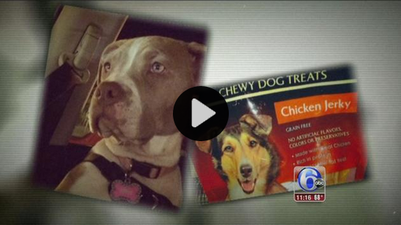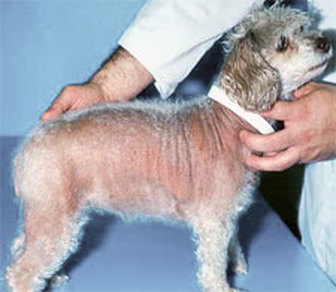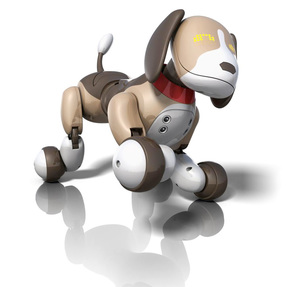 Your dog might seem like an unlikely source of renewable energy. But a new appliance is designed to take a plentiful resource your pet produces—dog poop—and convert it into electricity that can charge household gadgets. In theory, it's a way to keep dog turds off city sidewalks by giving owners an incentive to bring the waste home. "I have three dogs," says Geneva-based designer Océane Izard, who created "Poo Poo Power" as a conceptual design. "I have always believed in the potential of my dogs' droppings. I've also lost count of the times I've walked in shit." To use the appliance, dog owners place a biodegradable bag of dog waste inside, where sludge-eating bacteria belch out methane that is converted to power. The electricity is stored in detachable batteries that can be used around the house. The amount of power it produces depends on the dog. "For example, for a German shepherd, the amount of poo is different from that of a beagle," Izard says. "For a beagle, it creates between 250 and 340 grams of feces per day. This allows you to run a fan for two hours. For a German dog, it's twice as much. It could almost run your fridge." (If we wanted to power our homes completely via dogs—a ridiculous scenario that Izard calculated for fun—she says we would need six to seven dogs for every person). Izard thinks that the appliance would change how dog owners see poop. "For me it should not be taboo," she says. "Dog owners pick up their dog turds every day. This is certainly an ordeal. That's why there's so much in the streets. But with this machine, people will want to bring [home] this precious gift that their dogs do one to two times a day." The product could save money for cities like Paris, which cleans up around 12 tons of dog poop off city streets every day. It could also help tackle the overall problem of the scale of waste. In the U.S., dogs produce around 10 million tons of poop each year, and most of that waste goes to landfill—where it pumps methane, a potent greenhouse gas, into the atmosphere. Dog waste also pollutes watersheds; a study in Seattle found that as much as 20% of bacteria in local water came from dogs. Izard isn't the only one to consider using dog waste for power. The city of San Francisco considered a pilot program in 2006 to collect poop at dog parks and bring it to digesters, though the program ultimately didn't move forward. Another project aims to use dog poop to power streetlights at parks. Other projects, like the U.K.'s BioBus, convert human waste to power. "My project is an opportunity to say it is possible even at a small scale," says Izard. "The future of poop is here." Source: Co.XIST / Adelle Peters A Peaceful Farewell provides compassionate at home pet euthanasia to fellow pet owners in Chandler, Gilbert, Mesa, Tempe, Ahwatukee, Scottsdale, and most of the Greater Phoenix Metropolitan Area.
0 Comments
 By Helen Soteriou and Will Smale Business reporters, BBC News When Penny Lally passes away she is going to be buried between her late husband... and her favorite horse. The 71-year-old will join John Lally and her beloved old pony Super Sam in a picturesque woodland spot in Cornwall, south west England. Also already buried in the family plot are Blot the cat, Muppet the Alsatian dog, and Brian the canary. Elsewhere in the six acres (2.4 hectares) of woods and fields, some 40 other people are also laid to rest with their pets. The land is owned by Ms Lally's business, Penwith Pet Crematorium, which is one of 50 or so pet crematoriums and cemeteries across the UK. And businesses is booming, as an ever-growing number of pet owners wish to give their animals a more formal send-off. At Penwith they now individually cremate an average of 200 animals per week, double the number a decade ago. Prices range from £42 for a hamster or guinea pig, up to £187 for a large dog. Meanwhile, it costs £900 to bury a horse (they are too big to be cremated at Penwith), or £1,500 for a human being. Ms Lally says: "It was my silly idea to set up the business back in 1988." She adds that she came up with the idea when she realized that there were many people like her and her husband who would like give their pets a formal cremation or burial. And that others would, like them, also consider being ultimately buried beside their pets, or where their beloved animals' ashes were scattered or interred. "My husband and I were running a farm, and we were lucky enough to have the land to set up the business," says Ms Lally. "So we set aside six acres. The business then gradually grew from there thanks to positive word of mouth and repeat business. "Everyone who comes here goes away and happily recommends us to other people, and we get people who come back with their second and third pets." 'Pet parents' Far from being just a British phenomenon, the industry of pet cremation and burial, or "pet loss" as it is known, is now a very big business globally. According to US-based trade body Pet Loss Professionals Alliance (PLPA), the average annual turnover of its members around the world in 2013 was $860,464 (£556,000). And that year its members in the US alone cremated 1.46 million pets. Today, she owns and runs an organisation called Two Hearts Pet Loss, which educates veterinary professionals and pet loss businesses about how best to meet the needs of people whose pets nearing the end of their lives. Based in Indianapolis, Indiana, Ms Ellis, who is also the author of a book on the subject, says it is important to remember that there are two types people who have pets - "pet owners" and "pet parents". She adds: "My services are geared towards the pet parent, the person who saw their little furry animal as a member of the family. "I wanted to give people 'permission' to do what they wanted to do to honor their pet, and to honor the life they shared together. "We are giving them permission to do more, and possibly in an area where they may be felt like they were going to be shamed, or made fun of, because a lot of people may be looking at them and saying 'it was just a dog', or 'it was just a cat, why do you want to do that, that's crazy?'." 'Final goodbyes' Vivianne Dhupa and her husband Sarit Dhupa decided to go into the pet loss industry after a traumatic experience following the death of their then 17-year-old cat in 2004. Their cat died on route to their vets in San Diego, California, and the couple did not want to take its ashes back from the surgery. A few months later Ms Dhupa went back to ask where the ashes had been scattered, only to be told that the cat had been taken to an animal rendering plant, because the couple hadn't specifically requested cremation. "Needless to say, I was angry and devastated," says the 42-year-old. To prevent other pet owners going through a similar experience, the couple set up their own pet crematorium - Peaceful Paws Pet Crematorium. This now cremates 20,000 pets per year, and customers can choose from a range of specially designed pet urns. However, Ms Dhupa and her husband went one stage further, and also opened a hospice center for dying pets, the Into The Sunset Pet Transition Centre. Ms Dhupa says: "While our primary goal is to ensure our patients are pain-free and maintaining an acceptable quality of life, we focus a great deal on supporting the family emotionally. "We do not prolong life or hasten death. Our primary goal is quality of life until the family is ready for their final goodbye." Back in the UK, Carole Mundy, 61, has purchased burial plots at Penwith Pet Crematorium for her herself and her husband, and all of their cats and dogs. Plus three separate areas for her rescued horses. She says it has cost her thousands of pounds. "I wanted to find a resting place where I can be buried with all of my animals," she says. "They give me unconditional and devoted love, so why would I not want to be buried with them." Source: BBC A Peaceful Farewell provides compassionate at home pet euthanasia to fellow pet owners in Chandler, Gilbert, Mesa, Tempe, Ahwatukee, Scottsdale, and most of the Greater Phoenix Metropolitan Area.
Dogs, for all their familiar, comforting, domesticated presence in our homes, remain to me mysterious creatures. How an animal can predict epilepsy at one turn like some ethereal body scanner and drink out of the toilet the next moment is one of the great paradoxes of the universe; this capacity for strange miracles comingled with the banal. Some of the mystery surrounding dogs’ unusual prowess in sensing disease resides in their noses. The canine nose is thought to be between 10,000 and 100,000 times more sensitive than the human nose. In addition, a greater portion of their brain is dedicated to interpreting this massive amount of data. Given their aptitude to experience the world through their noses, it’s no surprise than among the many things dogs can sniff out, cancer is one of them. Dogs have been trained to correctly identify lung cancer on the breath, colon cancer in the stool, and bladder cancer in the urine. While we know dogs have been able to correctly identify the difference between ill patients and well ones, we still haven’t been able to isolate exactly what it is the dogs are smelling; inflammatory mediators, necrosis, or benzene derivatives secreted by cancer cells? Perhaps we’ll figure it out one day, but for now we can simply revel in the marvel of the idea of a dog breath-sniffer one day replacing the dreaded mammogram or colonoscopy. In a 2006 study in Integrative Cancer Therapy, dogs from Guide Dogs for the Blind were able to identify breast cancer patients 88 percent of the time. Until they were trained to identify the smell of cancer, these dogs had completed only basic obedience training, meaning this sort of sniff sensitivity isn’t limited just to certain “supersniffer” canines. Source: PetMD A Peaceful Farewell provides compassionate at home pet euthanasia to fellow pet owners in Chandler, Gilbert, Mesa, Tempe, Ahwatukee, Scottsdale, and most of the Greater Phoenix Metropolitan Area.
For better or worse, robots seem poised to take over all sorts of human jobs in the not-too-distant future -- replacing us in factories and offices and maybe even in the bedroom. And people may not be the only ones facing stiff competition from the cyborgs. According to an animal welfare researcher at the University of Melbourne in Australia, robots might soon replace our favorite pets. “It might sound surreal for us to have robotic or virtual pets, but it could be totally normal for the next generation,” Dr. Jean-Loup Rault said in a written statement. “It’s not a question of centuries from now. If 10 billion human beings live on the planet in 2050 as predicted, it’s likely to occur sooner than we think." Rault's not the only scientist that thinks robotic pets are on the way. Famed astrophysicist Neil deGrasse Tyson told The Huffington Post in an email: "Cars have replaced horses. Home security systems have replaced guard dogs. Internet kittens are cuter than your kittens. Pooper-scooper laws are unnecessary for cuddly stuffed animals on your bed. And your pet bird should have never been kept in a cage to begin with. Robot pets are inevitable. And possibly overdue." A matter of sustainability. More than half of people in Western societies own a pet, according to Rault. As the population grows and becomes increasingly urban, he believes owning flesh-and-blood companion animals is likely to become economically unsustainable for many people. "Efforts to develop cities designed to be green and pet-friendly are ongoing," he wrote in an opinion piece for journal Frontiers in Veterinary Science. "However, a more realistic future is that pets may become a luxury possession for people who can afford to sustain their cost and fulfill their needs in terms of space, social, and mental needs according to possibly higher ethical standards raised by future societies." But could a robotic Rover give its owners the same benefits as a real one? Studies have linked dog ownership with lower blood pressure, reduced anxiety, and higher self-esteem. And scientists at the University of Arizona are investigating whetherdoggy germs give our immune systems a boost. Maybe more to the point, could we love a pet that runs not on kibbles but electrical power? Would we accept affection from such a being? Transformative technology. A 2008 study showed that Sony's robo-dog AIBO helped nursing home residents in the U.S. feel less isolated. And funerals held for "dead" robotic dogs last March in Japan suggest that their owners really can develop a strong attachment to the devices. "For those who keep AIBOs, they are nothing like home appliances," Hiroshi Funabashi, a supervisor at a Japanese company that repairs the robo-dogs, told AFP. "It's obvious they think their (robotic pet) is a family member." Rault argues that robo-pet technology will soon be sophisticated enough to cover our emotional needs. “When engineers work on robotic dogs, they work on social intelligence, they address what people need from their dogs: companionship, love, obedience, dependence,” he said in the statement. But not everyone agrees our society will snuggle up to robodogs. Jason Silva, host of the National Geographic Channel's "Brain Games," sees a different future for humans and their pets. "Not sure if robot dogs will 'replace' our pets, but I wouldn't be surprised if we continue to engineer our best friends," he told The Huffington Post in an email. "Remember that dogs were our first biotechnology project. We bred them into existence in their current form. We engineered them." Source: Huffington Post A Peaceful Farewell provides compassionate at home pet euthanasia to fellow pet owners in Chandler, Gilbert, Mesa, Tempe, Ahwatukee, Scottsdale, and most of the Greater Phoenix Metropolitan Area.
 The Centers for Disease Control and Prevention (CDC) recently released their Morbidity and Mortality Weekly Report, which discussed a mini-outbreak of plague that occurred here in Colorado last year. Four people fell ill with the pneumonic form of the plague after coming in contact with a sick dog. The dog was euthanized before veterinarians could determine exactly what was going on (a full necropsy was not initially permitted), and it was only after one of the human patients was diagnosed with plague that follow-up testing revealed the cause of everyone’s illnesses. The word “plague” conjures up pictures of the Middle Ages and epidemics that killed millions of people, but it is simply the name given to the disease that results from infection with Yersinia pestis bacteria. Plague can take three forms:
In animals, plague is usually spread by fleas that feed on infected rodents, like prairie dogs (the most commonly affected species), rabbits, squirrels, mice, and rats. When an animal dies from the plague, the fleas leave the carcass to find another host, thus spreading the disease. Animals can also become sick after coming in contact with blood or tissues from another infected animal. This often happens through hunting or scavenging. Treatment for plague is straightforward and includes appropriate antibiotic therapy, supportive care, and isolating patients until they are no longer contagious. The CDC report on the cases in Colorado is notable for several reasons:
Now, plague is not a nationwide problem, but if you live or travel to the Western United States (especially the Four Corners region) you should take precautions, like these put forth by the Colorado Department of Public Health and Environment, to protect yourself and your pets:
Source: PetMD / CDC A Peaceful Farewell provides compassionate at home pet euthanasia to fellow pet owners in Chandler, Gilbert, Mesa, Tempe, Ahwatukee, Scottsdale, and most of the Greater Phoenix Metropolitan Area.
 With summer coming up, there's no need to leave Fido at home. Conde Nast Traveler editor Mark Ellwood explains how to best travel with your pet. Plus, he names a few pet-friendly destinations you should consider for your next trip! In the car:
On the plane:
At the hotel:
For more helpful tips from the experts at North Shore Animal League America, visit animalleague.org/expert-advice. Source: Emily Sher /TODAY A Peaceful Farewell provides compassionate at home pet euthanasia to fellow pet owners in Chandler, Gilbert, Mesa, Tempe, Ahwatukee, Scottsdale, and most of the Greater Phoenix Metropolitan Area.
 By Wendy Saltzman Thursday, May 07, 2015 11:41PM A popular pet treat is being blamed for deaths of more than 1,000 dogs but an Action News Investigation has found that some of these treats were on still on the shelves in spite of an FDA warning about possible dangers. Angela Popolizio was just 4 years old when her family rescued a half Shiatsu/half Pomeranian, they named Sammy. The two grew up together. "Even at 12 years old, he played like a puppy. He was perfectly healthy," said Popolizio. An annual exam in October confirmed Sammy was in good health. But just three months later, she says one small switch, one mistake changed everything. "He had one on Saturday. We gave him another one of the treats on Sunday," said Popolizio. Popolizio says she gave Sammy PetSmart's Authority brand chicken flavored teething rings made in China. "Monday he wasn't going to the bathroom, he wasn't moving. He kept drinking and drinking, but he wasn't eating," said Popolizio. Six days and multiple trips to the vet later, Sammy died. "I was sitting there and holding him in my arms, watching him pass away," said Popolizio. Then just a few miles down the road and one month later, Tammy Marshall says she fed her 10-year-old Chihuahua Gidget two Authority brand chicken jerky treats that were made in Thailand. "She's in here and she's wagging her little tail and I opened the treats and I gave her one. She came running back around and I gave her that second treat and that was the last thing she ate," said Marshall. Marshall noticed a similar response, Gidget wouldn't eat, but kept drinking more and more water. "There wasn't a whole lot of time from the time I fed her that treat, to the time that she died," said Marshall. "She was in kidney failure," said Darryl Francomacaro, veterinarian. Marshall took Gidget to her vet, Darryl Francomacaro, and to the CARES Emergency Hospital. "They took her back and she said, 'She's in complete organ failure and if you would like to put her down, you're doing her a favor,'" said Marshall. And it wasn't just Sammy and Gidget. We were also contacted by other families. Zena from San Diego passed away in January, just four days after her owner says she ate Authority chicken jerky treats. The owner of a German Shepard named Maggie from Alberta, Canada also says her dog got seriously ill after eating Authority treats in December, but fortunately did not die. "It says right here, on the bottom of the bag - 'Made in China,'" said Popolizio. The treats, while they are packaged in Phoenix, were made in China and Thailand. Marshall went on the FDA website and discovered a warning about their on-going investigation into chicken jerky treats from China. The FDA identified 5,800 illnesses, and more than 1,000 canine deaths associated with various brands of Chinese made chicken treats. "Why would you leave it on the market?" said Popolizio. Both Marshall and Popolizio say they complained to PetSmart. However when we went undercover, we found that the chicken jerky treats from Thailand were still stocked on store shelves across our area - in Philadelphia, New Jersey and Delaware. Marshall says they initially removed them at the store where she bought her bag, but then: "Five days later they were back on, on sale. You can kill your dog at a discount," she said. The FDA took Marshall's dog in for a necropsy, to determine the cause of Gidget's death, which her vets says showed her kidneys were dying from the inside out. "Normally when you see acute kidney failure, you think of poison, toxicities," said Francomacaro. We asked the FDA for interviews multiple times over two months. They declined, and instead they provided us with a "consumer video" while failing to answer our questions about whether all treats from Asia should be recalled. "We know that the illnesses and deaths reported are mostly linked to jerky pet treats with ingredients imported from China. Pet owners should be aware however the manufacturers do not need to list the country of origin for each ingredient used in their products," said Martine Hartogensis in an FDA video. At this point, even after all the testing, experts can't confirm the PetSmart Authority brand treats were the direct cause of Sammy and Gidget's deaths. PetSmart provided us with a statement saying: "Nothing is more important to us than the health and safety of pets, and we strive to provide the best quality products for pets and pet parents. As of March of this year, we removed all dog and cat treats manufactured in China from our shelves and online and no longer sell China-made dog and cat treats, which includes chicken jerky products. This was something we had been working toward for some time and felt it was the right thing to do for pets and our customers." "As far as the treats manufactured in Thailand, we follow all recommendations of the FDA and look to them for guidance. At this time, the FDA has not identified a direct cause of illness from chicken jerky pet treats, has not issued any kind of recall, and we have no reason to believe the Authority Chicken Jerky treats are unsafe. If this should change, we will take immediate action." -Erin Gray, PetSmart Spokesperson The FDA has only issued a limited recall of Chinese chicken jerky treats as their investigation continues into what exactly is making dogs sick. Their recall does not include the PetSmart brand. Symptoms may include vomiting, diarrhea, increased thirst, lethargy, and tremors. If your animal experiences any of these responses to chicken jerky treats, the FDA asks that you contact them directly. The FDA also gave us the following statement: "The FDA is continuing to investigate illnesses in pets associated with the consumption of chicken, duck, or sweet potato jerky pet treats. Treats are not required for a balanced diet, and pet owners should consult with their veterinarians prior to feeding treats to their pets. The FDA encourages pet owners and veterinarians to notify the agency about any pet illnesses through the agency's Safety Reporting Portal." Veterinarian Darryl Francomacaro says he thinks the FDA should recall all of these treats and recommends if someone sees the treats they are buying are made in Asia, consider something else. Source: 6abc.com A Peaceful Farewell provides compassionate at home pet euthanasia to fellow pet owners in Chandler, Gilbert, Mesa, Tempe, Ahwatukee, Scottsdale, and most of the Greater Phoenix Metropolitan Area.
Though cat owners may want to depend on a cat to clean herself, there may be a time when you will want to give your cat a bath. The following tips will help you and your cat have a more pleasant experience. Prior to the bath, you will want to groom your cat. Use a grooming glove, fine-toothed comb, or soft brush for shorthaired breeds and a wide toothed comb and a soft slicker brush for longhaired breeds. Brush your cat thoroughly being especially gentle on the skin because it is thin and sensitive. Also, make sure to brush out any mats you may find - they are much harder to remove from wet hair. This is also a good time to check for sores, abscesses, lumps, and other skin problems. Clean your cat's ears and look for any excess wax or debris in the ears. You will also want to clip your cat's nails at this time. If your cat does not enjoy any of these procedures, wait until your cat has calmed down before starting the bath. Assemble all the materials you will need before you get the cat. Include a soft towel andshampoos and conditioners formulated especially for cats. If the shampoo is very thick, it is sometimes helpful to dilute it with some water before applying it to the cat. Just prior to the bath, place cotton balls in the ears and apply ophthalmic ointment to protect the eyes. Place a towel in the bottom of the sink or tub you are going to use to prevent slipping. Be sure the area where you give the bath is warm, and your cat will have a warm place to dry off. Remember that cats do not like to be restrained, so the less she feels like you are controlling her, the better. Speak in soft tones and try to appear calm, since your cat will become more nervous if she senses you are apprehensive. Signs that your cat is anxious include flattening of the ears or whiskers, tail thumping, loud vocalizations, and open mouth panting. Use lukewarm water. Cats generally dislike sprays, so it is often better to pour water over the cat rather than spraying. If you must spray, avoid hard sprays and spraying near your cat's face. You may want to wrap your cat in a thin towel and wet the coat through the towel, remove the towel, and then apply the shampoo. After shampooing, rinse your cat thoroughly. Rinsing is the most important step. The old adage is: 'Once you think you've rinsed your cat thoroughly, rinse her again.' Dry your cat gently with a towel. 'Blotting' is better than rubbing, especially in longhaired breeds. Longhaired breeds will also benefit from an additional brush out and a blow dryer on no-heat setting (if your cat will tolerate the noise). If your cat absolutely cannot tolerate being wet, try using a waterless or powder shampoo, pre-moistened bath towelettes for pets, or give your cat a 'sponge bath' with a damp towel. Remember, the younger a cat is when you begin to bathe her, the more likely it will be that she will come to enjoy an occasional bath. Source: peteducation.com A Peaceful Farewell provides compassionate at home pet euthanasia to fellow pet owners in Chandler, Gilbert, Mesa, Tempe, Ahwatukee, Scottsdale, and most of the Greater Phoenix Metropolitan Area.
 What’s Causing the Dog Hair Loss? Seeing a dog lose his or her hair can be disconcerting to witness. However, what’s most important when dealing with alopecia, as it is referred to medically, is identifying the underlying cause of the hair loss in order to devise an appropriate treatment plan. Here are five common culprits of hair loss in dogs that should be discussed with your veterinarian. 1. Allergies Allergies are a frequent cause of hair loss in dogs. This may due to environmental triggers such as pollen, molds and dust mites, or due to parasitic triggers like fleas or mites. Food allergies are another possible cause of hair loss. Typical symptoms of an adverse allergic reaction include itchiness resulting in excess scratching, biting, and, of course, hair loss. In the case of flea allergies, it is recommended that dogs take flea preventatives as a way to minimize threats of a full-blown flea infestation. 2. Infection or Infestation An infestation with parasites such as fleas, ticks, and mites (scabies, mange) is another source canine alopecia. Along with hair loss around the ears, eyes, abdomen, and chest, signs your dog may have mites or fleas/ticks include inflammation, itching and redness. Bacterial or fungal infections, such as in the case of ringworm (which is actually a fungus), can also be attributed to hair loss in dogs. Symptoms of ringworm include circular or irregular hair loss, inflammation, and infected crusts. 3. Cushing's Disease Hyperadrenocorticism, also known as Cushing's disease, is a condition caused by the prolonged exposure of the body’s tissue to excessive levels of the hormone cortisol. Symptoms of Cushing’s disease include hair loss, darkening of the skin, and the development of a pot-bellied abdomen. Cushing’s disease commonly occurs in middle-aged to senior dogs, though it can also affect dogs that overuse corticosteroid drugs. 4. Genetics There are some breeds of dog that are more genetically prone to baldness than others. First there are the hairless dogs that have been bred for the attribute such as the Chinese Crested, Mexican Hairless (Xolo), and American Hairless Terrier. Other dog breeds, such as the Doberman Pinscher, Dachshund, Chihuahua, Italian Greyhound and Whippet, sometimes suffer from patchy or pattern baldness on the outer ear, chest, back, thigh, or lower neck. 5. Pressure Sores Pressure sores, also called bedsores or decubital ulcers, are localized injuries where the dog’s elbows or other bony pressure points (hips, hocks, etc.) come into contact with hard surfaces regularly. This constant pressure and friction causes the skin to callus, lose hair and sometimes crack and bleed. Pressure sores are more common older dogs, especially large or heavy breeds. A Peaceful Farewell provides compassionate at home pet euthanasia to fellow pet owners in Chandler, Gilbert, Mesa, Tempe, Ahwatukee, Scottsdale, and most of the Greater Phoenix Metropolitan Area.
A Wisconsin woman is facing an animal neglect charge in South Dakota for allegedly having 42 dogs and cats in a sport utility vehicle. Spearfish police officers responding to an animal welfare call last weekend found the 36 toy-breed dogs and six cats inside the vehicle. The Black Hills Pioneer reports most of the animals were housed in what police said were cramped, dirty kennels with no food or water. Lisa Dietzel, 54, of Shullsburg, Wisconsin, was arrested. She faces a misdemeanor charge that carries a maximum punishment of a year in jail and a $2,000 fine. It was not immediately clear if she had an attorney. Police say Dietzel was traveling back home from Washington state when she stopped in Spearfish. Police took the animals to a shelter. Source: AP A Peaceful Farewell provides compassionate at home pet euthanasia to fellow pet owners in Chandler, Gilbert, Mesa, Tempe, Ahwatukee, Scottsdale, and most of the Greater Phoenix Metropolitan Area.
|
The PAW Blog...
For the LOVE of Pets The goal of this blog is to help educate pet owners by sharing pet health facts and pet news articles...and ... sometimes put a smile on your face with a cute or funny pet story! Categories
All
Archives
July 2024
Search for any topic...
|


 RSS Feed
RSS Feed

